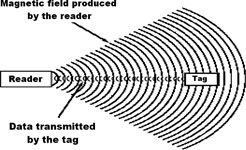How they work: RFID transponders
22 February 2006
Telecoms, Datacoms, Wireless, IoT
Radio frequency identification (RFID) is the system of using radio signals to send information identifying a particular situation or item. It can be used to track and locate any item including material, people and animals.
There are two major components in a radio frequency identification (RFID) system:
1. The tag (transponder) programmed with unique information.
2. The reader (interrogator) includes a decoder to interpret data.
The tag consists of an integrated circuit (IC) and a coupling device. The IC stores specific data unique to that tag. The coupling devices interfaces with the reader.
The RFID transponder coil is part of the coupling device and acts as the transmitting antenna. The key specifications of the transponder coil are sensitivity and read distance. However, the inductance (L) of the transponder coil directly influences the sensitivity and the read distance. Generally, a higher inductance provides greater sensitivity resulting in a longer read distance. The manufacturer of the tag usually specifies the inductance of the coil to be used. The read distance is defined as: the maximum distance from the reader that the transponder responds to the reader's magnetic field.
When the reader receives the transmitted data, it interprets the data and takes appropriate action. When the transponder enters the field produced by the reader, the coil produces a voltage inside the tag. In a passive transponder, this voltage can be used to power the tag. In an active transponder, the voltage is used to wake the tag and use its internal battery.
Figure 1. The reader produces a magnetic field that triggers the tag
Active transponders generally have longer read distances, shorter operational life and are larger and more costly to manufacture. Passive transponders are generally smaller, have a longer life and are less expensive to manufacture.
For optimum performance, the transponder coil is used in a parallel LC circuit as shown in Figure 2. Adding a capacitor to the circuit maximises the read distance. The LC circuit is designed to resonate at the operating frequency of the reader.
Figure 2. The LC circuit is designed to resonate at the operating frequency of the reader
The following equation is used to calculate the value of the capacitor:
C = 1/[L * (2 Π * frequency)²
For example: to calculate the capacitor value for a 4,9 mH transponder coil operating at 125 kHz:
C = 1/[0,0048 * (2 Π * 125000)²
= 3,308E-10
= 331 pF
Fastron's transponder coils are wirewound, surface mount antennas, designed for use in 125 kHz RFID systems. They are rated for 125 μC operation.
Further reading:
What does Wi-Fi 7 mean for South African networks?
Telecoms, Datacoms, Wireless, IoT
With Wi-Fi 7 (802.11be), we are finally looking at a standard that was built, not just for more devices, but for the new way networks are used.
Read more...
Multiprotocol wireless SoC
RF Design
Telecoms, Datacoms, Wireless, IoT
The nRF54LM20A from Nordic Semiconductor is a multiprotocol wireless System-on-Chip designed for demanding designs in Bluetooth devices.
Read more...
High performance communication
iCorp Technologies
Telecoms, Datacoms, Wireless, IoT
Quectel’s FCS950R is a high-performance Wi-Fi 5 and Bluetooth 4.2 module that can deliver a maximum data rate up to 433,3 Mbps in 802.11ac mode.
Read more...
Expanded STM32WL3x line for IoT sensors
Altron Arrow
Telecoms, Datacoms, Wireless, IoT
The STM32WL31x and STM32WL30x are more tailored versions of the STM32WL33x for designers who wish to focus on specific features, while lowering their bill of materials.
Read more...
Full-band GNSS helical antenna
RF Design
Telecoms, Datacoms, Wireless, IoT
A key feature of Calian’s HC3990XF antenna design is that it does not require a ground plane, making it ideal for size-constrained applications.
Read more...
BLE and BT Mesh module
iCorp Technologies
Telecoms, Datacoms, Wireless, IoT
The HM-BT4531 from HOPERF is a BLE data transmission module that features an ARM Cortex-M0 32-bit processor.
Read more...
Espressif entering the Wi-Fi 6E market
iCorp Technologies
Telecoms, Datacoms, Wireless, IoT
Espressif Systems is entering the Wi-Fi 6E market, extending its connectivity portfolio into the domain of high-throughput, low-latency wireless solutions.
Read more...
Ultra-low jitter clock buffers
Altron Arrow
Telecoms, Datacoms, Wireless, IoT
New SKY53510/80/40 family of clock fanout buffers from Skyworks are purpose-built for data centres, wireless networks, and PCIe Gen 7 applications.
Read more...
Cutting-edge broadband power amplifier
RFiber Solutions
Telecoms, Datacoms, Wireless, IoT
Designed for high efficiency and reliability, the WPGM0206012M from WAVEPIA is a cutting-edge broadband GaN MMIC power amplifier operating from 500 MHz to 8,5 GHz.
Read more...
The trends driving uptake of IoT Platform as a Service
Trinity IoT
Editor's Choice Telecoms, Datacoms, Wireless, IoT
IoT platforms, delivered as a service, are the key that will enable enterprises to leverage a number of growing trends within the IT space, and access a range of benefits that will help them grow their businesses.
Read more...



